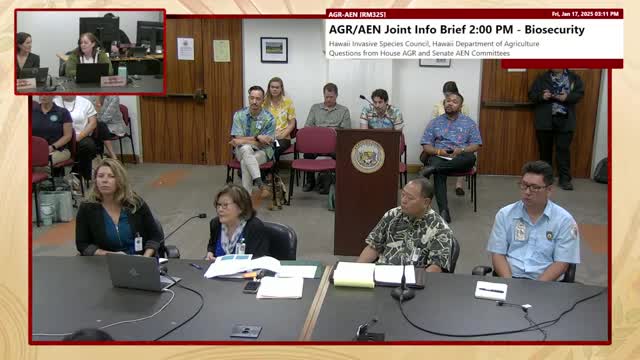DLNR seeks funding for watershed protection, wildfire prevention and aquatic invasive response
January 18, 2025 | House Committee on Agriculture & Food Systems, House of Representatives, Legislative , Hawaii
This article was created by AI summarizing key points discussed. AI makes mistakes, so for full details and context, please refer to the video of the full meeting. Please report any errors so we can fix them. Report an error »

The Department of Land and Natural Resources told the Jan. 17 joint House–Senate biosecurity briefing that protecting priority watershed forest, managing wildfire fuels and building aquatic invasive‑species inspection capacity are top priorities that require new recurring and capital funding.
The agency outlined a portfolio of work that connects terrestrial restoration, wildfire risk reduction and marine biosecurity: watershed fencing and ungulate removal reduce spread of pathogens such as rapid ʻŌhiʻa death (ROD), fuels management reduces wildfire risk and post‑fire invasive grasses, and aquatic inspections at ports and coasts limit introductions such as invasive soft corals and anemones.
Ryan Kanakaole, first deputy for DLNR, said the state has committed to protecting 30% of priority watershed by 2030 and that 22% of that goal is currently protected. DLNR requested $5 million per year in capital improvement project (CIP) funding for fiscal 2026 and 2027 to build fences and begin ungulate removal in priority watersheds; Kanakaole said prior legislative CIP dollars leveraged more than $80 million in non‑state matching funds since 2013.
DLNR also told committees it needs expanded staffing. The department said it is seeking 22 permanent positions approved by the legislature last session to augment forest management, fuels mitigation and emergency response capacity, and that its executive budget requested $4 million recurring for operations (the department said actual need is larger, about $7.45 million).
On marine biosecurity, Division of Aquatic Resources staff described rapid response work in coastal waters. DAR recounted 20 reports of newly introduced aquatic species in state waters since 2020 and said it removed nine of those with no subsequent detections. An invasive anemone (Majano) discovered in Kaneohe Bay in 2024 is a high concern because it can smother native coral; DAR staff said funding and rapid intervention are needed to prevent spread beyond the detection site.
DLNR officials also flagged a forthcoming federal rule under the Vessel Incidental Discharge Act and said the state needs staff and inspection capacity to co‑enforce ballast and hull fouling controls expected by late 2026; the department warned that stony coral tissue loss disease (SCTLD) has expanded regionally and could arrive via vessel discharges. Lizzie Monahan, a biologist with DAR’s aquatic invasive species team, said sterilization methods for ballast water are not fully effective against SCTLD and noted a recent report of SCTLD near the Panama Canal, increasing the risk of spread to Hawaii.
What’s next: DLNR asked lawmakers to fund the CIP request and the additional positions, and to support co‑enforcement planning for vessel discharge rules; the department said it will continue rapid response removals where new aquatic invasives are found and will expand watershed protection to meet the 2030 target.
The agency outlined a portfolio of work that connects terrestrial restoration, wildfire risk reduction and marine biosecurity: watershed fencing and ungulate removal reduce spread of pathogens such as rapid ʻŌhiʻa death (ROD), fuels management reduces wildfire risk and post‑fire invasive grasses, and aquatic inspections at ports and coasts limit introductions such as invasive soft corals and anemones.
Ryan Kanakaole, first deputy for DLNR, said the state has committed to protecting 30% of priority watershed by 2030 and that 22% of that goal is currently protected. DLNR requested $5 million per year in capital improvement project (CIP) funding for fiscal 2026 and 2027 to build fences and begin ungulate removal in priority watersheds; Kanakaole said prior legislative CIP dollars leveraged more than $80 million in non‑state matching funds since 2013.
DLNR also told committees it needs expanded staffing. The department said it is seeking 22 permanent positions approved by the legislature last session to augment forest management, fuels mitigation and emergency response capacity, and that its executive budget requested $4 million recurring for operations (the department said actual need is larger, about $7.45 million).
On marine biosecurity, Division of Aquatic Resources staff described rapid response work in coastal waters. DAR recounted 20 reports of newly introduced aquatic species in state waters since 2020 and said it removed nine of those with no subsequent detections. An invasive anemone (Majano) discovered in Kaneohe Bay in 2024 is a high concern because it can smother native coral; DAR staff said funding and rapid intervention are needed to prevent spread beyond the detection site.
DLNR officials also flagged a forthcoming federal rule under the Vessel Incidental Discharge Act and said the state needs staff and inspection capacity to co‑enforce ballast and hull fouling controls expected by late 2026; the department warned that stony coral tissue loss disease (SCTLD) has expanded regionally and could arrive via vessel discharges. Lizzie Monahan, a biologist with DAR’s aquatic invasive species team, said sterilization methods for ballast water are not fully effective against SCTLD and noted a recent report of SCTLD near the Panama Canal, increasing the risk of spread to Hawaii.
What’s next: DLNR asked lawmakers to fund the CIP request and the additional positions, and to support co‑enforcement planning for vessel discharge rules; the department said it will continue rapid response removals where new aquatic invasives are found and will expand watershed protection to meet the 2030 target.
View full meeting
This article is based on a recent meeting—watch the full video and explore the complete transcript for deeper insights into the discussion.
View full meeting
